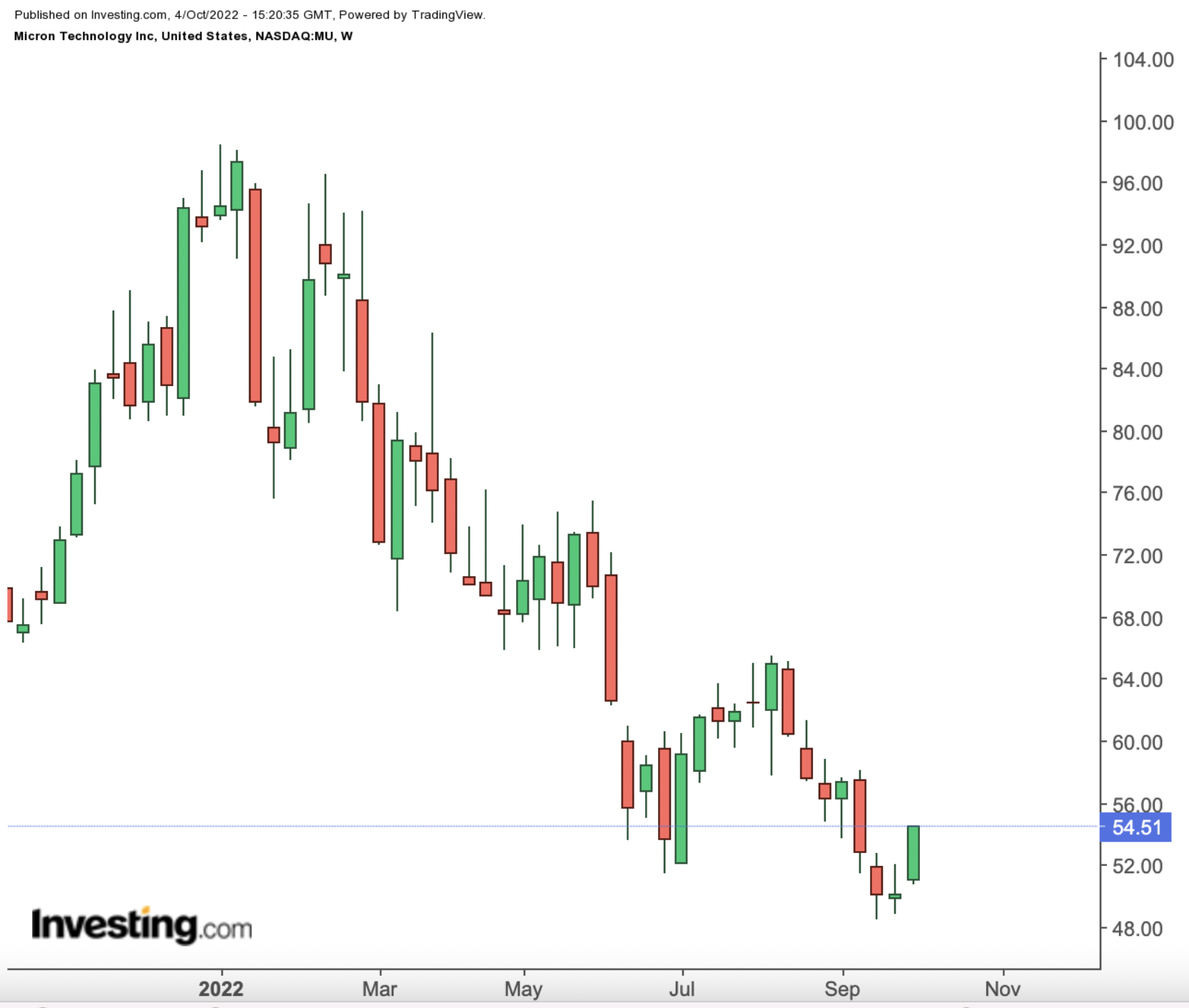- So far, the market has shrugged off last week’s disappointing outlook from Micron
- The long view makes some sense, as Micron is an intensely cyclical company
- One key question: How long will investors take that long view? And are there better opportunities in the meantime?
On Thursday afternoon, Micron (NASDAQ:MU) delivered a seemingly disastrous outlook for the first quarter of its fiscal 2023. The average Wall Street estimate projected revenue of $5.62 billion in Q1, along with earnings per share of 64 cents. Micron guided for revenue of $4 billion to $4.5 billion, and an EPS of roughly break-even.
Yet, investors essentially shrugged. MU stock actually gained 0.18% in trading last Friday, and another 3.2% Monday.

Source: Investing.com
The reaction does make some sense. Micron is an intensely cyclical company, and it’s no surprise that the cycle is turning against the company. Demand for personal computers and smartphones is drying up: even Apple (NASDAQ:AAPL) reportedly is walking back a planned production increase.
In that context, it seems likely that MU stock price incorporated disappointing guidance more quickly than Wall Street analysts could update their models.
After all, this is nothing new. Micron’s earnings historically have been highly volatile. Investors who time that volatility correctly have done well. Those who get it wrong, have not. That history suggests Micron stock remains a long-term buy. It also indicates that patience probably is advised.
We’ve Been Here Before
The outlook for the fiscal first quarter implies plunging year-over-year profits. Micron estimates EPS ranging from a 14-cent profit to a 6-cent loss after earning $2.16 in the year-prior quarter.
But this is the nature of the memory-chip business. Again, when the cycle turns, it turns quickly and severely. In fiscal 2016, the company generated adjusted EPS of 26 cents. The following year, the figure was $4.96. By FY18, Micron was earning nearly $12 per share; profits were nearly halved the following year.
The core driver of this volatility is pricing. When demand is high, Micron can take pricing, and almost every dollar of pricing drops straight to the pre-tax bottom line. When demand recedes, the effect reverses.
Is MU Stock Expensive?
In theory, the market should account for this volatility by pricing MU stock accordingly. At the peak, the price-to-earnings multiple should be low. At trough earnings, that multiple should expand. And, indeed, the market generally has applied this strategy, as witnessed by MU trading as low as 4-5x earnings during 2018.
Of course, this is easier said than done. The outlines of the cycle aren’t always obvious, as current Wall Street estimates for fiscal 2023. Looking back 90 days ago, the consensus EPS expectation for FY23 sat at $11. It’s now below $1.
On its face, that consensus would seem to argue MU stock is a sell at $51, and thus roughly 55x this year’s profit. But, again, that’s not how valuing MU is supposed to work. Investors need to account for what mid-cycle earnings look like and go from there.
The Long-Term Case For Micron Stock
The good news, even assuming a soft FY23 performance, is that mid-cycle earnings still look reasonably strong. Through the cycle, Micron is not going to be as profitable as it was in FY18 (when adjusted EPS neared $12), or even necessarily FY22 ($8.35).
But by the same token, a sub-$1 performance in FY23 would not be reflective of underlying earnings power. Even assuming consensus expectations play out, the five-year average for EPS still should come in around $5.
Backing out almost $4 per share in net cash on the balance sheet, then, MU is trading at just under 10x its five-year average EPS — again, including an ugly FY23. In that context, it’s not terribly surprising that the same analysts projecting roughly $1 per share in profit this year have an average price target of $66.
There’s another aspect to consider as well. Part of the reason the memory business was so cyclical in the past was because of the strategic decisions of the industry players. Memory mimicked most commodity businesses (like crude oil).
Prices would rise on the back of stronger demand. As a result, manufacturers would raise production. When demand receded, that higher production led to a glut. As a result, prices would plunge.
But memory players have insisted for a few years that they plan to avoid those boom/bust dynamics. For the most part, they have. Indeed, Micron with its Q4 results announced plans to cut its capital spending by some 30%, and Japanese rival Kioxia is doing the same. The industry remains cyclical, but at least Micron and its peers aren’t adding to that cyclicality.
Timing The Bottom
All told, there’s some logic to the lack of reaction to the first-quarter guidance, and to being bullish on MU stock even as earnings are set to decline sharply. But there’s one more factor to consider: timing.
In theory, investors will stay patient through the bottom of the cycle, and keep their eyes firmly planted in the future toward the next upswing. In practice, it doesn’t always work that way.
A nervous market probably is going to dump Micron stock while it’s unprofitable, whether it should or not. If, as Monday’s rally suggests, a bottom is in, there are probably more aggressive, potentially more profitable plays to choose at the moment.
As a result, there is a case for patience here. MU stock should turn back north before its earnings do — but neither is guaranteed to happen immediately.
Disclaimer: As of this writing, Vince Martin has no positions in any securities mentioned.
